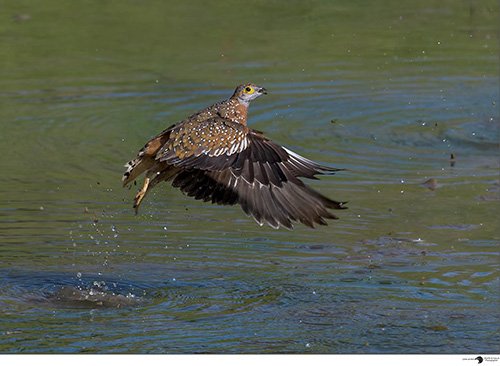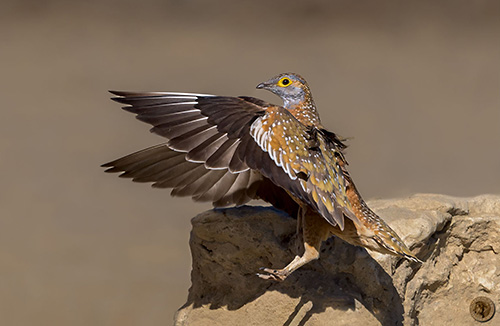
Fr: Ganga de Burchell
Ang: Burchell's Sandgrouse
All: Fleckenflughuhn
Esp: Ganga Goteada
Ita: Grandule di Burchell
Nd: Bont Zandhoen
Sd: pärlflyghöna
Photographer:
Callie de Wet
GALLERY
Text by Nicole Bouglouan
Sources:
HANDBOOK OF THE BIRDS OF THE WORLD vol 4 by Josep del Hoyo-Andrew Elliott-Jordi Sargatal - Lynx Edicions - ISBN: 8487334229
BIRDS OF AFRICA SOUTH OF THE SAHARA by Ian Sinclair and Peter Ryan - Princeton University Press Princeton and Oxford - ISBN: 0691118159
BIRDS OF SOUTHERN AFRICA – By Ian Sinclair, Phil Hockey and Warwick Tarboton – Princeton Field Guides - Princeton and Oxford – ISBN: 0-691-09682-1
ROBERTS BIRDS OF SOUTH AFRICA by G. R. Mc Lachlan and R. Liversidge – The Trustees of the John Voelcker Bird Book Fund – ISBN: 0620031182
SABAP2 - Burchell's Sandgrouse
BirdNote - The Feathers that Carry Water
Creagus – SANDGROUSE Pteroclidae
Sandgrouse - From Wikipedia, the free encyclopedia
Wikipedia, the free encyclopaedia
Burchell's Sandgrouse
Pterocles burchelli
Pterocliformes Order – Pteroclidae Family
INTRODUCTION:
The Burchell's Sandgrouse is found in Southern Africa where it occurs from SE Angola to Namibia, Botswana and N South Africa.
It can be found in areas of rough grass and scattered shrubs, but it generally prefers the areas with red Kalahari sand. It feeds mainly on seeds of legumes, especially those of the Red Pea.
The species is monogamous and nests on the ground in a shallow depression protected by vegetation. Both adults share the nesting duties.
The name of this species pays tribute to the English naturalist William John Burchell (1781-1863).
The Burchell's Sandgrouse is described as common to fairly common, and the species is not globally threatened at the moment.

DESCRIPTION OF THE BIRD:
Biometrics:
Length: 25 cm
Weight: M: 180-200 g – F: 160-185 g
The Burchell's Sandgrouse male has reddish body plumage mottled with white speckles and darker shades of brown.
On the upperwing, the flight-feathers are blackish-brown. The greater coverts show broad, white edges. The tail is short with pointed central rectrices.
On the underparts, flanks, axillaries and underwing are deep rufous, except the dark flight-feathers. Rest of underparts is cinnamon with white spots, especially on breast and belly.
On the head, the superciliary stripe, sides of face, chin and throat are grey.
The bill is black. The eyes are brown, surrounded by conspicuous, bare, yellow eyering. The dusky yellow legs and feet are relatively long.
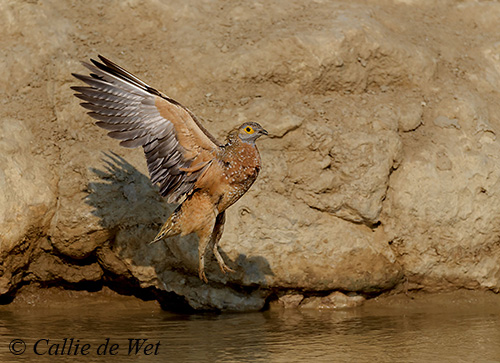
The adult female resembles a drab male, but she has yellowish-buff, not grey, face and throat. The belly is paler. She is usually duller than male.
The juvenile resembles adults. The young male has greyish-buff throat and superciliary stripe.
RANGE:
The Burchell's Sandgrouse is found in Angola, Namibia, Botswana, Zambia, Zimbabwe and South Africa.
HABITAT:
The Burchell's Sandgrouse in Southern Africa is found chiefly among the red sand dunes of the Kalahari or sandveld.
It occurs in arid or semi-arid areas, and in areas of rough grass and shrubs. It depends on water availability and the seeds it manly consumes. But it is absent from the arid areas along the west coast.
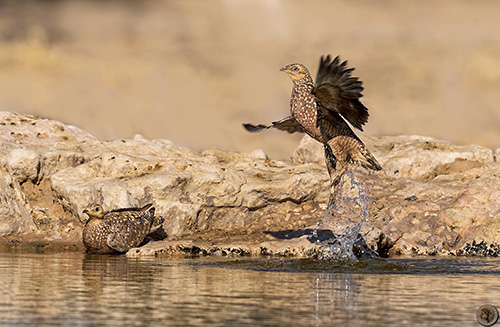
CALLS AND SONGS: SOUNDS BY XENO-CANTO
The flight call of the Burchell's Sandgrouse is a soft, fairly high-pitched, mellow “chup-chup, choop-choop”. This call is given in flight but also around the waterholes. The take-off is accompanied by sharp, repeated “quip”.
BEHAVIOUR IN THE WILD:
The Burchell's Sandgrouse feeds primarily on seeds, especially those from legumes such as the Red Pea.
It often forages in pairs or small flocks during the day. The food is mainly taken off the ground, but sometimes directly from the plant. They usually drink in the morning, 2-3 hours after sunrise. They are gregarious but they form separate feeding groups away from the waterhole.
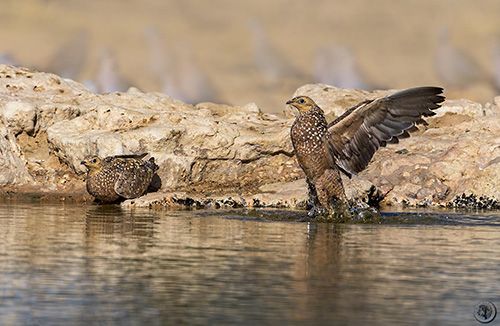
The Burchell's Sandgrouse is monogamous and solitary nester. The nest is on the ground, concealed among the vegetation. Both parents incubate and care for the chicks.
The courtship displays of this species are not described, but several members of this family perform rather sketchy and unspectacular displays, including the wings held away from the body and the tail raised and fanned out. The male may sometimes run after the female with the tail fanned out and the head held tucked into the body. Some species perform aerial displays, often in groups flying around in circles at considerable height and speed.
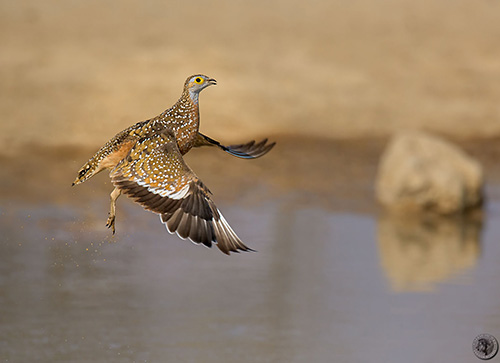
After hatching, the chicks need to drink but they cannot fly. The sandgrouses are able to carry water in their belly feathers.
The male rubs its belly on the ground, probably to reduce the oily film on the plumage before to take water into the feathers. Then, it enters the water and ruffles its belly feathers while rocking to and fro.
Before to reach the chicks, it walks with the legs wide apart. Then, it stands in an erect “Watering Posture” allowing the chicks to remove the water from the feathers. Following this behaviour, the male rubs its belly on the ground again, probably to dry the feathers.
This behaviour is performed mainly by the male, because the female does not have the same amount of absorbent feathers.
The Burchell's Sandgrouse is sedentary, but it may undertake local nomadic movements to find both food and water.
The wings of the sandgrouses are relatively long, and this is a “high-speed” type of morphology, providing strong, direct, sustained flight. The speed may reach up to 60-70 km/h. The bird is able to keep up the speed over long distances, with continuous wingbeats.
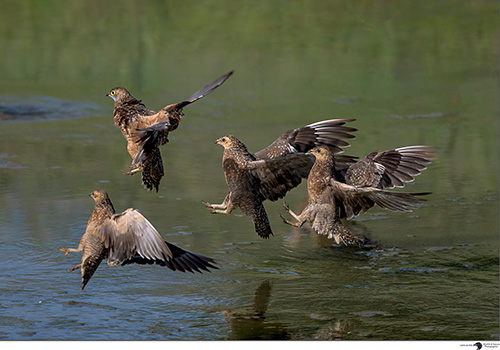
REPRODUCTION OF THIS SPECIES:
The breeding season takes place during the dry season in winter, with the laying between April and October.
The Burchell's Sandgrouse makes a simple nest, a shallow depression on the ground, protected by some vegetation such as grass tussock or bush. The cup is lined with some pieces of dry vegetation.
The female lays 3 eggs, rarely 2 eggs. Both parents share the incubation with the male mainly at night. The duration of this period is unknown for this species, but it normally lasts 20-25 days for most Pteroclidae species. The chicks are precocial when they hatch, and they leave the nest as soon as their down is dry. They are soon able to run with their parents. Both adults do all the parental care until the young birds become independent, usually 3 weeks after hatching.
The water is brought to the chicks by the adults, mainly the male, in the specialized feathers of both belly and breast.
Jackals, eagles and various raptors and scavengers are predators of the chicks.
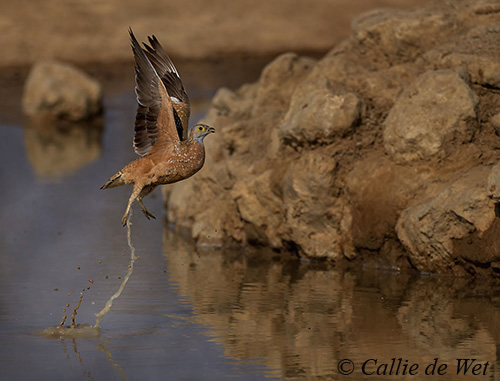
PROTECTION / THREATS / STATUS:
The Burchell's Sandgrouse is described as common and widespread in Botswana, locally common in Transvaal state in South Africa, common in E Namibia, abundant in Gemstock National Park, and uncommon in Angola.
The size of the population is unknown, but it is suspected to be stable.
The species has benefited from the surking of boreholes by stock farmers, allowing the sandgrouses to colonize more arid areas than previously possible.
The Burchell's Sandgrouse is currently evaluated as Least Concern.
